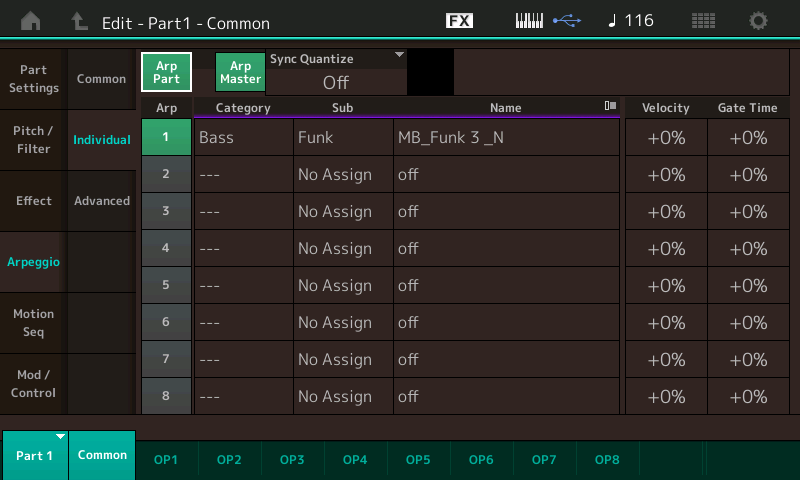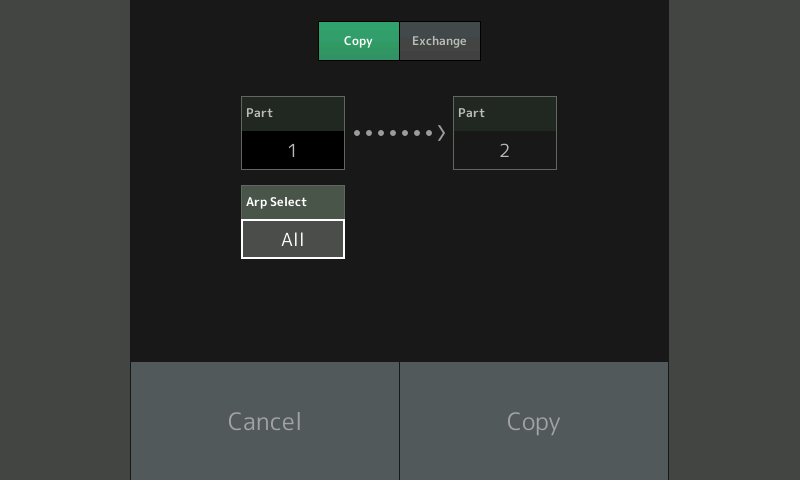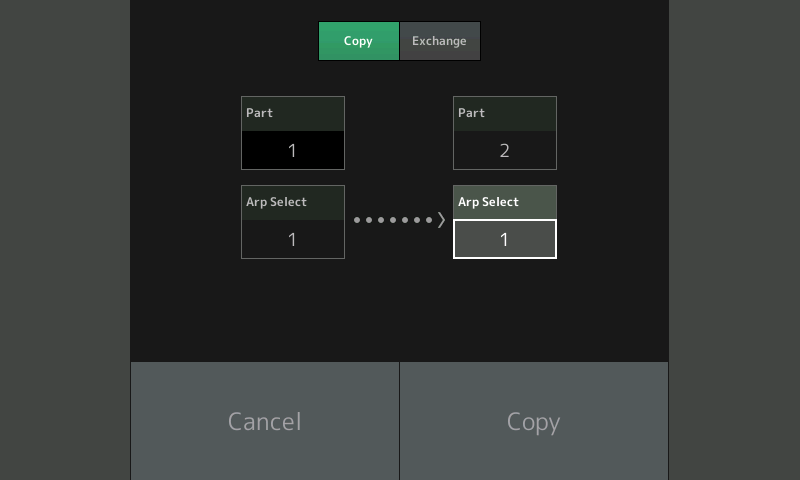Is there an easy way to copy arp params from one part to another?
I think, it‘s in the manual, but I can‘t find it.
Thank you in advance
[SHIFT] + [EDIT] from the home screen can copy (or exchange) Parts. So if you copy a Part to a different Part then you'll get everything including the arpeggio settings copied to the new Part.
There's not a way, inside of MODX, to copy just the ARP settings.
Otherwise, JMtools can be used to do this on a computer. If I recall, I believe you already have JMtools. This is probably the best way - since the interface allows for "cut and paste" of settings.
Or you could use a computer and do bulk transfers which amounts to some bit of programming or scripting on your PC to accomplish.
I have gotten accustomed to doing extra work using Yamaha keyboards through the years. I usually take out a piece of paper and write down the parameters then manually update. Sometimes I take pictures of the screen and reference a picture rather than notes on paper. I wish it were easier than this - but it just never has been using the on-board features.
Current Yamaha Synthesizers: Montage Classic 7, Motif XF6, S90XS, MO6, EX5R
Is there an easy way to copy arp params from one part to another?
I think, it‘s in the manual, but I can‘t find it.Thank you in advance
Yes, you can copy Arpeggios from one Part to another within a Performance; either just one or All of them. Here’s how: No need to take out a piece of paper or write anything down, lol.
In your Performance, select the source Part.
Navigate to the Part “Arpeggio” area... there are three screens “Common”, “Individual” and “Advanced”
Say you are reviewing the assigned Individual Arp assigned to the current Part.

From that screen press [SHIFT] + [EDIT] — this is always the context sensitive way to launch a COPY or EXCHANGE function. (Alternatively, from the HOME screen, tap “Motion Control” > “Arpeggio” - here you see the overview for all Part. You can launch the COPY/EXCHANGE from here, as well).
You will see the screen that lets you setup for the Copy/Exchange. You want to be on the Part that you wish to Copy (it’s data will automatically populate the Source Part box). In the screenshot below, since I started in Part 1, "Part 1" already occupies the source box...
Set the target Part and choose to Copy a specific Arp Select or simply Copy them All.

You set the target Part and whether you want to Copy All or you can just one of the Arp Selects to the target Part.

@J
I have gotten accustomed to doing extra work using Yamaha keyboards through the years. I usually take out a piece of paper and write down the parameters then manually update. Sometimes I take pictures of the screen and reference a picture rather than notes on paper. I wish it were easier than this - but it just never has been using the on-board features.
Sometimes, it IS! lol
___ the COPY/EXCHANGE feature for Arp Select assignment has been in the MODX since its release
See the MODX Reference Manual page 86 for details.
___ the COPY/EXCHANGE feature for Arp Select was added to MONTAGE way back in version 1.20
See the latest MONTAGE Supplementary Manual page 122
A new Supplementary Manual is released with each firmware update, and the latest one issued will include all previous updates. One should always remember to check them before concluding something is not available.
Thank you so much ??
What ARP Copy/Exchange doesn't copy or exchange are most of the ARP settings.
Arpeggio -> Common and Arpeggio -> Advanced
Not sure which parameters were targeted in the original request.
For these parameters: JM, paper/pictures, or computer-assist scripting/programming/advanced MIDI monitor.
Current Yamaha Synthesizers: Montage Classic 7, Motif XF6, S90XS, MO6, EX5R
The firmware copies the Arp Select assignment, what it does not copy is those things that are offsets and/or add-ons to the Arp Phrase data; those things not apart of the Arpeggio Phrase (Type) itself... Those things that would be stored in Scenes, for example (which are offsets to the Arp Selection, not apart of the Arpeggio data itself). These additional things are, technically speaking, Part parameters. Part parameters can copied in a different routine. (detailed below... )
__ The “Arpeggio” > “Common” parameters are found, for the most part, in the current Scene. (You can store 8 different versions of these using Scene Memory) — they are applied to the current Arp Selection. Viewing the Scene offsets allows you to easily duplicate your settings to adjacent Parts (if that is your goal). There can be 8 different sets of these Play FX offsets per Performance.
These offsets appear on the Part Arpeggio Common screen and are viewable in the Scene Memory “Arp/MS” as Play FX. In order to memorize more than one set, turn the Scene Memory Switch = On for “Arp/MS”. If you have setup a Swing Quantize back on the Arpeggio Common screen you will see it reflected in Scene 1 when you activate the Memory Switch for this data.
__ The “Arpeggio” > “Advanced” parameters deal with those items that determine how the Keyboard will interact with the assigned Arp through this Part. This behavior is in response to keyboard... Velocity, and the Trigger Modes, for example. Not Arpeggio data, but more ‘how’ the Arpeggio data assigned to the Part will work with the Keyboard... does it follow KeyOn Velocity or play as pre-programmed, does it trigger an accent phrase, and when (at what Velocity) does it trigger it. Consider these “Part” parameters that can be applied to the selected Arpeggio Phrases.
If you want to copy the Part settings, you can use [SHIFT] + [EDIT] while the source Part is *selected* on the HOME screen.
Copying the entire Part will include all the settings for that Part... including those that are being attached as offsets and/or are appended to the data.
Possible Reasons to Copy Arp data:
__ Copying the same Arp to an adjacent Part would be to apply the same ‘phrase’ to a different instrument sound.
Or, if you are building a multiple Part single instrument sound (where the exact same settings would be required in each Part)
I’ve found that the most prudent workflow is to build up from Part 1, applying as many of the decisions about what all Parts will share in common (if you are going to apply an arpeggiator phrase to an 18 Element acoustic piano across several Parts...or you want to apply the same Insertion Effects to all components. This way you can simply COPY Part 1 to the adjacent locations, then change just the things that will differentiate the component Parts.
Following this type of workflow...
__ You can copy the entire Part then have the firmware feature replace or not just the things you want. You can use the “Part Category Search” to accomplish the goal of having the new selection inherit your “Common” and your “Advanced” Arpeggio settings, for example.
No paper, promise. See below...
Extra Credit:
Here’s how that works... if you are wishing to have all your Arp settings (both the Common and the Advanced offsets) moved to another Part, you would start with selecting the source Part, let’s say it is Part 1
[SHIFT] + [EDIT] to Copy Part 1 —> to the target Part location 2-16, let’s say Part 2
This will completely duplicate everything about the original Part into the target Part slot (this includes the Arp Selections and all of the offsets, and key Velocity and Trigger Mode settings... it is a complete clone. But it is not the sound we want... the firmware allows you to change just the program in the Part slot — leaving all other programming you might be concerned about, intact.
Now, because an instrument actually occupies the target slot (Part 2), you can use “Part Category Search” to replace just the instrument. You will be opting out on ”Parameters with Part”... by deselecting “Mixing”, “Arp/MS”, “Scene”, (Zone, if Zone Master is active), you can define what gets inherited and what gets replaced for your new instrument. Now when you select the new instrument for the target Part, it can inherit the Arp and all of the settings you require.
No paper, no photos, no writing anything down.
There are three Searches for sounds...
Performance Category Search — which replaces the entire Performance program
Performance Merge — a search that is initiated by tapping “+” when you are adding a Part, or Parts, to empty Part slots
Part Category Search ([SHIFT] + [CATEGORY]) — used when you are replacing a Part already occupying a slot.
It is this “Part Category Search” that allows you to opt in or out on bringing along the offset baggage (additional Part parameters appended to the program), like the original programming Volume, Pan, Send settings, Note Limits, etc., etc., its Arp and Motion Sequence assignments and offsets, its Scene settings, its Zone settings... you can have the new instrument you select for this occupied slot inherit the existing settings you have already put in place.
When you opt out (grey) on the “Parameters with Part” you are simply replacing the instrument program - and you can select/deselect the extras you want. Be sure you turn the option grey before actually *selecting* the program in the result field. This is very useful when you are creating a split program... and you want to try out different left hand sounds... by opting out on the MIXING option, your new selection will inherit the Split Point (Note Limits) you have already established. So you can quickly audition different left hand sounds without re-establishing your Note Limits each time!
Hope that helps (and retires your paper, and camera, or at least gives them a bit of a break).
For more on Searching for sounds: Mastering MODX — Category Search
Quick Question:
Being a bit of tidiness nut, I frequently want to clear out all the ARPs from a given part so they're all set to 'Off'. This is mostly because pretty much all pre-defined multi-part performances include ARPs, and I don't always remember to use the above prescribed methods when adding a new part. Previously, I would go to each of the ARPs and set them to 'Off' using the numeric entry option and choosing zero. Unfortunately, when a User ARP is present, this doesn't work, so I have to use other methods.
Recently, I discovered that I could literally exchange all ARPs in a given Part with a non-existent Part (16, for example), which then sets all 8 to 'Off'. If I need to do this a 2nd time, I use the next available unused Part (15, in this case). It's a bit of a hack, so I thought I would throw it out to you and see if maybe I'm doing something incorrectly.
Thanks.
Seems reasonable to me. Some factory presets seem to have more "residue" than others. So I'd double check after doing this.
Init Normal (AWM2) should also have no ARPs - so you could always load this Performance (as a Part) into an empty Part slot first in order to exchange the ARP assignments (or copy to overwrite w/o exchange).
Current Yamaha Synthesizers: Montage Classic 7, Motif XF6, S90XS, MO6, EX5R
Quick Question:
Being a bit of tidiness nut, I frequently want to clear out all the ARPs from a given part so they're all set to 'Off'.
No points for being a “tidiness nut”. LOL. You realize an associated Arp is meaningless because of the Part Arp On/Off and Master Arp On/Off switches?
The “Part Category Search” routine described above (as you noted you know about) allows you to recall a Program for the selected Part and have it inherit the current setting. Therefore, unless you are an “additional work nut” in addition to being a “tidiness nut” why not just create an initialized Performance where the Arps are all set to Arp Number = 0, this way you can *replace* each slot Part-by-Part while opting out on the “Parameter with Part” for “Arp/MS”.
Extra Credit:
Use the MODX CONNECT utility program to store your own custom INITIALIZED “Init Performance” — one where the settings default the way you desire... by having a customized Init template of your own, you will be able to inherit the default settings by using the “Part Category Search” to build your Performances. (You will need to add Multi Part selections one Part at a time, but then again, you won’t have to tidy up the Arp assignments).
From the article “What is MONTAGE CONNECT?” ....
Performance Capture and Recall: MONTAGE/(MODX) Connect captures and recalls the exact Performance used when creating a Project in a DAW. It does so by synchronizing the data to and from the instrument's Edit Buffer. When starting a new Project, MONTAGE/(MODX) Connect can recall your customized Default Performance. This means if you like a particular grouping of instrument sounds setup in a Performance when recording to a DAW, the Connect plug-in can recall and send that to your instrument. You can create any arrangement of instruments and select "Save as Default...".
This can be utilized even when using the CONNECT utility as a standalone program, simply name your Performance appropriately and retrieve it prior to starting any session.
Alternative Method:
Or as an alternative you can keep your default “tidy” Performance in a Library location... this way it will always be available for use (like when it is not convenient to run CONNECT). Trust me... the reason I know all of this is because I know exactly what you are referring to... so my laughter is with you, not at you. When preparing tutorial programs, I often try to “tidy up” so that the person following the tutorial does not get led astray by some setting not being used...
Simply use you own template as your go-to starting point when building your own Performances.
